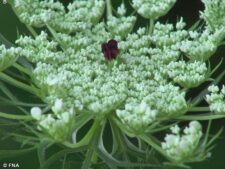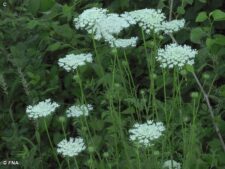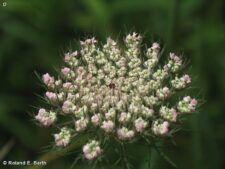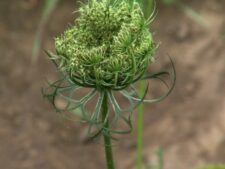
QUEEN ANNE’S LACE
Daucus carota
PARSLEY FAMILY (Apiaceae)
 Identification
Identification
- Flowering time - June, July, August, September
- Common at FF; Uncommon at NW along parking lot edges, roadsides or other disturbed sites
- Flat topped, umbrella shaped flower cluster (compound umbel) often with red center
- Fern like leaves
- Long, narrow, often forked bracts immediately below the flower cluster
This naturalized biennial was introduced from Europe. The second year an erect plant grows to 4 feet tall, with carrot-like leaves at the base. Long hairy stems carry flat-topped clusters (compound umbels) of white (A,B,C), sometimes pink (D,E,F) flowers, usually with a dark red or purple central flower (A,B). Directly beneath the flower cluster are many long narrow, often forked, bracts (A,G). When mature, the umbels curl inward (F,G) resembling a bird’s nest.
Flowers from June through September on disturbed ground along roads, parking lots and floodplain trails. Common and spreading at both Fontenelle Forest and Neale Woods.
This plant is the ancestor of our cultivated carrot. It is considered a weed in Nebraska and is being controlled in our two nature centers by uprooting. Identified by its flat-topped flower clusters on long leafless stems and the cluster of bracts below the flower clusters. Poison Hemlock (Conium maculatum) looks somewhat similar, but has branched stems.
The content of NatureSearch is provided by dedicated volunteer Naturalists of Fontenelle Forest who strive to provide the most accurate information available. Contributors of the images retain their copyrights. The point of contact for this page is: Roland Barth.






